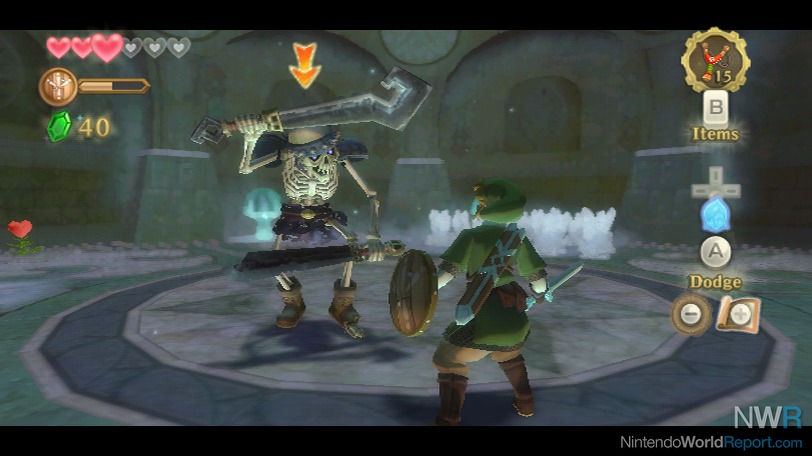With one release, Nintendo justifies the existence of Wii MotionPlus.
Scroll down to the bottom for a video review.
I’ve always seen the 3D Zelda games as following a clear progression, or at least attempting to. The triumph of those games is that they improve the formula over time, whether it’s the leap in combat (Ocarina being quite basic, Wind Waker adding parrying, and Twilight Princess adding even more layers) or the streamlining of gameplay (Command Melody in Wind Waker vs. the Dominion Rod in Twilight Princess). Those types of improvements are integral to the latest Zelda game, The Legend of Zelda: Skyward Sword, which carves its own path as the next great game in the series.
However, not only is Skyward Sword the next great Zelda game, it is also the ultimate proof of concept for why motion controls should exist. Simply put, Wii MotionPlus adds a whole lot to the experience that, at first glance, seems superfluous. The sword combat early on can be rough, since it requires you to be much more aware of the direction you swing the Wii Remote/sword, but the game is designed to ease you in. It gives you time to learn the mechanics and rules, clearly laying them out to you at a fine pace. Eventually, you’ll be mowing down enemies at a nice clip without taking hits. It’s a challenging system, especially when you have to deal with shields that can weaken and break if you mistime your parry with the Nunchuk.

The weapons you gain all have their own nuance to them as well. Bombs can be thrown or bowled, and MotionPlus even reads subtle tilt, allowing you to play Bowling for Bokoblins. Because of the flexibility of the weapons you acquire, there are often multiple ways to solve puzzles and fight enemies. One person might use the beetle to flip a switch, while another might use the slingshot. You can use the sword to slice Deku Babas, toss a bomb at them so they eat it and explode, or fly the beetle at one to cut its stem. If you love a weapon, chances are you can upgrade it using the new forging mechanic. It’s totally optional, as you don’t have to upgrade a single weapon throughout the story, but the upgrades are meaningful, adding new functionality to your items. For example, the slingshot gets a scatter technique that fires off multiple seeds at once.
The line between the world and dungeons is blurred throughout all of Skyward Sword. Each of the game’s main adventuring areas are like dungeons in themselves, as you’ll have to solve puzzles, fight enemies, and fight mini-bosses before you even make it to what older games would label a dungeon. This setup allows the dungeons to be significantly trickier and much more focused. The amount of creativity expressed in the dungeons and the overworld is wondrous. It falters at times, especially as you revisit areas multiple times and complete numerous fetch quests that sometimes feel like padding, but the game holds up very well over a 35+ hour experience.
The bosses, for one of the first times in the series, don’t seem to slavishly follow the typical three-hits-to-kill pattern. With the exception of a few duds, the bosses are an excellent mix of spectacle and challenge. Some highlights include a (highlight for boss spoilers)battle with a giant sea monster on a pirate ship, and a high-flying battle against a parasite-infested flying whale. The final series of bosses are suitably epic as well.
The bosses are quite challenging, but if you get stuck, don’t fret. Nintendo’s use of the Super Guide in Skyward Sword is nothing sort of masterful. Basically, you have access to a multi-layered FAQ in the game. Your Navi-esque character, Fi, gives you vague hints initially. Then, after some time, she spells it out a little more clearly. And if you get really stuck, you can back out to Skyloft and view teasing hint videos at a Shiekah Stone.

I won’t go too deep into the game’s story, but I will say it does indeed link to the series as a whole. It doesn’t have moments that rival the gravity of Wind Waker, but it tells a coherent story that features well-directed cut scenes and fantastic dialog. The localization team at the Treehouse outdid themselves, as there are quite a few sly series and pop culture references.
Skyward Sword is an epic, the sort of epic you call out of work or school for a few days to complete. A focused playthrough will take you north of 30 hours, and if you try to 100% the game, there is a 50+ hour quest to go through. Throw in the second quest, dubbed Hero Mode, and there is a lot of game to play.

Not only is The Legend of Zelda: Skyward Sword the ultimate Zelda game, it’s also the ultimate Wii game. You can see bits and pieces of nearly every other Zelda game and any game Nintendo has worked on with motion controls, from Super Mario Galaxy and Wii Sports Resort to Wii Music and Animal Crossing. If you bought a Wii, you owe it to yourself to get this game right away. After all, isn’t one-to-one swordplay what made us all excited about the Wii in the first place?


